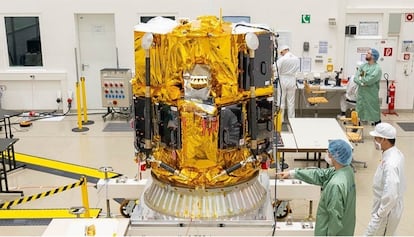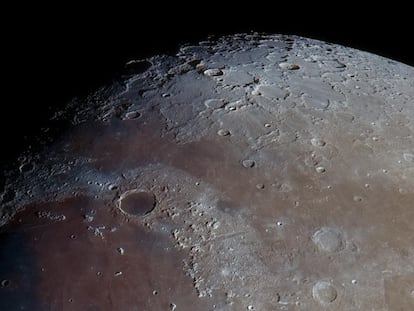Crash of private Japanese moon lander blamed on software and last-minute location switch
The CEO of ispace says the company is still on track to attempt another moon landing in 2024

A private Japanese moon lander went into free-fall while trying to land on the lunar surface last month, company officials said Friday, blaming a software issue and a last-minute switch in the touchdown location.
The spacecraft belonging to the company ispace was originally supposed to land in a flat plain. But the target was changed to a crater before December’s launch. The crater’s steep cliff apparently confused the onboard software, and the 7-foot (2-meter) spacecraft went into a free-fall from less than three miles (five kilometers) up, slamming into the lunar surface.
The estimated speed at impact was more than 300 feet (100 meters) per second, said the company’s chief technology officer, Ryo Ujiie.
NASA’s Lunar Reconnaissance Orbiter photographed the crash site the next day as it flew overhead, revealing a field of debris as well as lunar soil hurled aside by the impact.
Computer simulations done in advance of the landing attempt did not incorporate the terrain of the new landing site, Ujiie said.
CEO and founder Takeshi Hakamada said the company is still on track to attempt another moon landing in 2024, and that all the lessons learned will be incorporated into the next try. A third landing attempt is planned for 2025.
If successful, ispace would have been the first private company to successfully land a spacecraft on the moon. Only three governments have achieved that: Russia, the United States and China. An Israeli nonprofit tried in 2019, but its attempt also ended in a crash landing.
Named Hakuto, Japanese for white rabbit, the spacecraft and its experiments were insured, according to Hakamada. The United Arab Emirates had a mini lunar rover on board that was lost in the crash.
Two U.S. companies have lunar landers awaiting launch later this year from Cape Canaveral, in partnership with NASA.
Sign up for our weekly newsletter to get more English-language news coverage from EL PAÍS USA Edition
Tu suscripción se está usando en otro dispositivo
¿Quieres añadir otro usuario a tu suscripción?
Si continúas leyendo en este dispositivo, no se podrá leer en el otro.
FlechaTu suscripción se está usando en otro dispositivo y solo puedes acceder a EL PAÍS desde un dispositivo a la vez.
Si quieres compartir tu cuenta, cambia tu suscripción a la modalidad Premium, así podrás añadir otro usuario. Cada uno accederá con su propia cuenta de email, lo que os permitirá personalizar vuestra experiencia en EL PAÍS.
¿Tienes una suscripción de empresa? Accede aquí para contratar más cuentas.
En el caso de no saber quién está usando tu cuenta, te recomendamos cambiar tu contraseña aquí.
Si decides continuar compartiendo tu cuenta, este mensaje se mostrará en tu dispositivo y en el de la otra persona que está usando tu cuenta de forma indefinida, afectando a tu experiencia de lectura. Puedes consultar aquí los términos y condiciones de la suscripción digital.
More information
Últimas noticias
NASA discovers Titan doesn’t have an ocean, but a ‘slushy ice layer’ that increases possibility of life
Innocence lost in the forest of the child soldiers: ‘Each leader of the armed group had his girls’
‘Fallout’ or how the world’s largest company turned an anti-capitalist apocalyptic Western into a phenomenon
From inflation to defending migrants: Eileen Higgins and Zohran Mamdani inaugurate the new Democratic resistance against Trump
Most viewed
- ‘El Limones’ and the growing union disguise of Mexican organized crime
- Christian Louboutin: ‘Young people don’t want to be like their parents. And if their parents wear sneakers, they’re going to look for something else’
- The low-cost creative revolution: How technology is making art accessible to everyone
- ‘We are dying’: Cuba sinks into a health crisis amid medicine shortages and misdiagnosis
- Liset Menéndez de la Prida, neuroscientist: ‘It’s not normal to constantly seek pleasure; it’s important to be bored, to be calm’










































